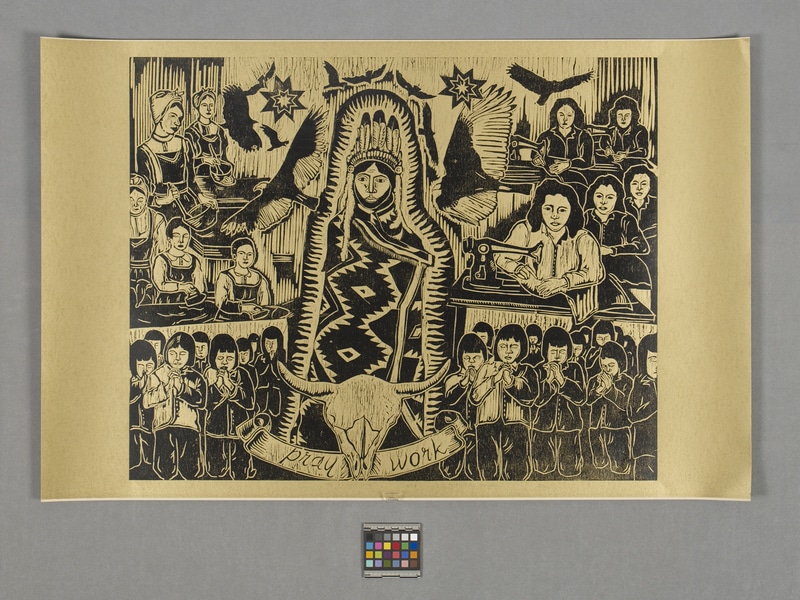Be a Good Girl Item Number: 3087/1 from the MOA: University of British Columbia

Description
Woodblock print in black and gold, from edition of 4. The image shows figures/scenes in black on a gold ground. A central, vertical figure stands wrapped in a blanket, wearing a feather headdress. Above fly eagles and ravens. Below is a buffalo skull and a banner saying “pray/ work”. Along both sides girls and young women are shown in different scenes cooking, ironing, sewing and praying on their knees.
Narrative
Artist Statement from her 2013 exhibition: “'Be a Good Girl' is a reflection on the gendered work expectations and training of women in the 1950s. I have explored this topic by looking at Indian residential schools, and the ways in which young Native women were trained in an effort to transform them into good working-class wives and workers. The Indian residential school system had a half-day labour program for girls, which was abolished in 1952 out of concern that children were not receiving an education, but were only serving the financial needs of the school. Residential schools forbade Native children from speaking their languages or practicing their culture in an attempt to mold them, for their “salvation,” into productive members of white, capitalist society. The residential schools were part of a dark history of racism and genocide in Canada and continue to have negative effects. This sort of gendered work training, however, was not reserved for the assimilation of Natives; training schools like the Ontario Training School for Girls rehabilitated young women with “loose” morals and other traits that were not tolerated in the ’50s. Both white working class and Native girls attended these training schools. This piece is about the conflicts, spiritual paradoxes, and societal expectations of young women in the ’50s."
Item History
- Made by Tania Willard (Maker) in British Columbia, Canada during 2013
- Owned by Red Willow Designs before November 16, 2014
- Received from Red Willow Designs (Seller) and Museum of Anthropology Acquisitions Budget (Funding source) on November 16, 2014
What
- Name
- Be a Good Girl
- Identification Number
- 3087/1
- Type of Item
- Overall
- height 66.4 cm, width 101.9 cm
- Image
- height 61.2 cm, width 76.2 cm
Who
- Culture
- Interior Salish: Secwepemc
- Creator
- Tania Willard (Maker)
- Previous Owner
- Red Willow Designs
- Received from
- Red Willow Designs (Seller) and Museum of Anthropology Acquisitions Budget (Funding source)
Where
- Holding Institution
- MOA: University of British Columbia
- Made in
- British Columbia, Canada
When
- Creation Date
- during 2013
- Ownership Date
- before November 16, 2014
- Acquisition Date
- on November 16, 2014
Other
- Item Classes
- works on paper
- Condition
- excellent
- Current Location
- Case 30
- Accession Number
- 3087/0001